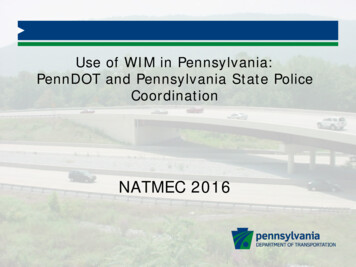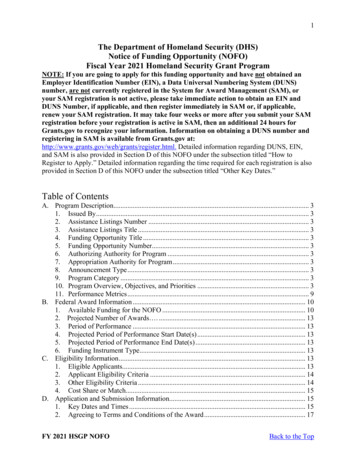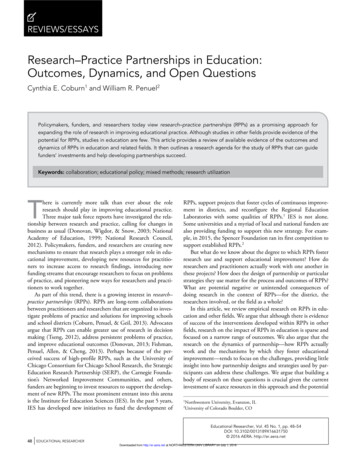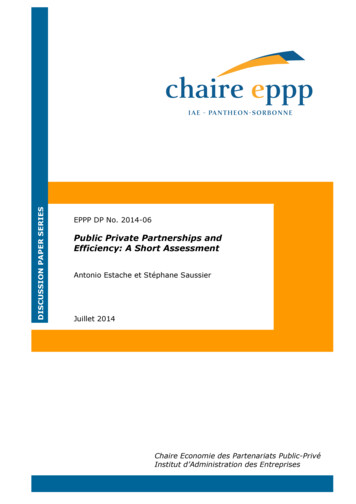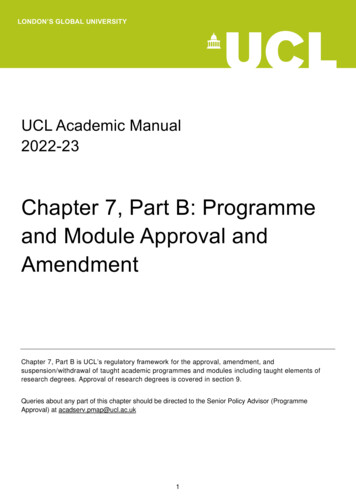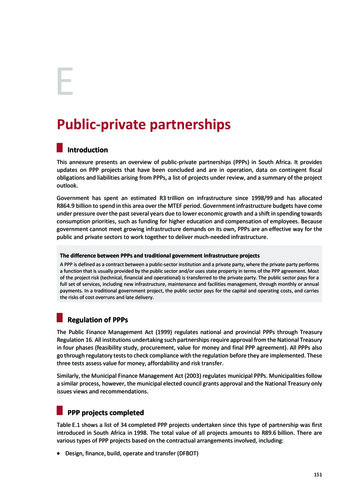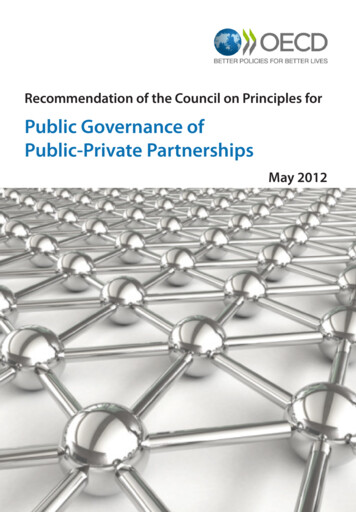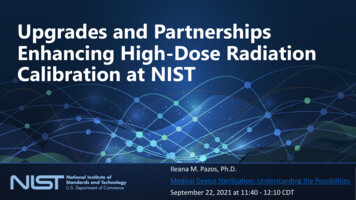
Transcription
Upgrades and PartnershipsEnhancing High-Dose RadiationCalibration at NISTIleana M. Pazos, Ph.D.Medical Device Sterilization: Understanding the PossibilitiesSeptember 22, 2021 at 11:40 - 12:10 CDT
Today’s topicsCalibrationservicesLab renovationand moveAcquisition ofnew irradiatorConsensus valueto scale e-beamERDScollaborationNOACcollaboration
NIST High Dose calibration services Calibration Irradiations of Customer Supplied Dosimeters with Co-60 Gamma Rays (4901XC)Standard geometrydosimeters Dose Interpretation of Customer-Irradiated NIST Transfer Dosimeters (4902XC and 4903XC)Dosimetry for High-Dose /high-dose-dosimetryQuality System for Calibration Irradiation and Transfer ures
NIST storefrontOn March 27, 2019, NIST introduced a new online shopping experience to order Calibration services.Click here to access the new NIST storefront
Renovated EPR facility 4 EPR spectrometers and support instruments moved to renovated space. Services are suspended during the move, setup and testing. Revalidation of the service is in progress.
EMX enhancements𝑆 𝑎𝑙𝑎𝑛𝑖𝑛𝑒EPR calibration curves 𝑟𝑢𝑏𝑦 EMXAla/Rub/weight𝑆Ala/Rub/weightECS
Automatic pellet exchange systemVirtual summer student project: vacuum pen, pellet tray, pellets,and a robot arm were sent to the student’s home.Next steps: setup near EMX and integrate in auto-collection.
Dose Rate EffectLimiting upper dose for alanine dosimetersRate effect is estimated to be zero at dose rates above 2 Gy/s significant at some value below 2 Gy/s, and clearly measurable at 1 Gy/sRate effect depends on absorbed dose, it is not measurable at 1 kGy or less becomes significant above 5 kGy reaches a maximum effect at about 30 kGyThe effect is intrinsic to alanine and is not dependent on thechemical form or manufacturing formulation of the alaninedosimeter.The study postulated that the production of one (or more) of theradiation-induced alanine radicals is dependent on the dose rate. NH3CH3CHCO2-RadicalCation RadicalAnionDesrosiers et al., 2008 and Desrosiers and Puhl, etrology-dosedose-rate-effects-alanine-dosimetryno measurableparamagnetic speciesCH3CHCO2- NH3
Acquisition of new irradiatorThe Hopewell Designs, Inc. Model GR420 High Dose Rate Self-Contained Research Irradiator is a modernreplacement for the legacy systems which are no longer supported.The GR420 combines the well-known and understood capabilities and features of legacy systems withnumerous state-of-the art design upgrades including larger chamber volume, a rotating chamber, higherprecision timing/process control and greatly improved external (operator) dose f-contained-irradiators/
NIST traceability NIST high-dose calibrationsand irradiation services areperformed in GammaCellCo-60 irradiators(designated GC). Metrology is based onalanine-EPR dosimetry,traceable to the primarystandard watercalorimeter under the Co60 vertical beam (VB).GR420
ComparisonsCCRI-S3The Consultative Committee forIonizing Radiation (CCRI) thirdsupplementary comparison (S3)of standards for absorbed doseto water in Co-60 gammaradiation was completed7 laboratories participated9/21/2021New NIST irradiatorDose rate determined bycomparison to NISTirradiators ( 5 kGy)International comparison forhigher dose will becompletedvalidate GR420ASTM Proficiency TestProficiency Test Plan for theCharacterization andEvaluation of High-DoseDosimetry Techniques inRadiation Processingindustry comparison11
Revalidation planPhase I:March –TBDPhase II:TBDPhase III:TBDPhase IV:TBDSuspend HD T&G(all doses)Irradiator lab # 2renovation completeand receive GR420Move EPR lab torenovated space;Set upspectrometersUpdate HazardReviews/SOPsUpdate HazardReviews/SOPsInitial safety anduniformity testingPartial operationIrradiator lab # 1renovation begins T full range G 1 kGy *Update HazardReviews/SOPsRe-establishcalibration curves 5 kGyUsing legacyirradiatorsEstablish dose rate &traceability. Determinegeometry &temperaturecorrection factors;ComparisonsRevalidaterestart T&G 5 kGyValidate and startT&G 100 kGyHD - high doseT - transfer calibration serviceG - irradiation calibration service* - lower dose range TBD G 1 kGy *Renovation ofirradiator lab # 1 iscompletedFully operationalEPR LabIrradiator Lab #1Irradiator Lab #2
Scaling factor for high energy electron beamReview of literaturefrom the last 15years on scalingfrom Co-60 toelectron beams.Recommendationby the leadlaboratoriesproviding alaninecalibration services.An overallconversion factor of1.014 (standarduncertainty 0.5 %)was obtained.Alanine dosereadings determinedfrom a Co-60 alaninecalibration should bemultiplied by thisfactor to yield thedose delivered in anelectron beam.
2021 CIRMS meetingIndustrial Applications Subcommittee
Emergency Radiation Dosimetry System NIST and Global Resonance Technologies LLC are developing arobust, sensitive and portable device to rapidly measure theamount of radiation received by exposed individuals in theaftermath of a mass-exposure nuclear event. Small embedded dosimeters in ID cards are a cost-effectiveway of distributing large numbers of dosimeters as a pre-eventmitigation strategy. Smaller alanine dosimeters coupled with an EPR system that can detect 1 – 5 Gycould be adapted to industrial needs. Plastic encapsulation could be coded and tracked. The new dosimetry system has been demonstrated to be suitable for electronbeam radiation/emergency-dosimetry
NIST on a Chip By measuring the temperature rise in silicon devices due toradiation absorption, NIST researchers have taken the firststep toward a miniaturized version of the conventionalcalorimetry technique. The chip-based device detects how heat energy affects theproperties of light passing through microscopic channelsbeing irradiated by gamma rays or an electron n/photonic-sensors By leveraging nanomanufacturing and telecommunicationstechnology, the new sensor promises highly accuratereadings at smaller dimensions. Exploring different doping strategies that would result inaccumulated defects would convert this calorimeter into adosimeter.
STAY IN TOUCHCONTACT USNIST.gov@nist
Emergency Radiation Dosimetry System NIST and Global Resonance Technologies LLC are developing a robust, sensitive and portable device to rapidly measure the
